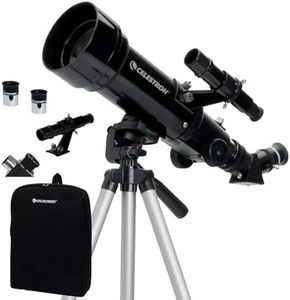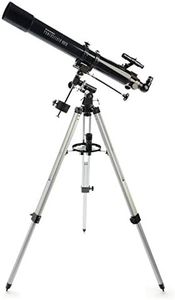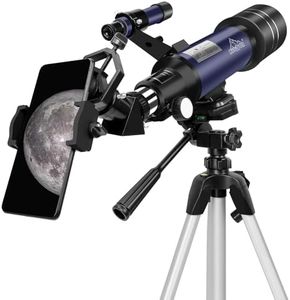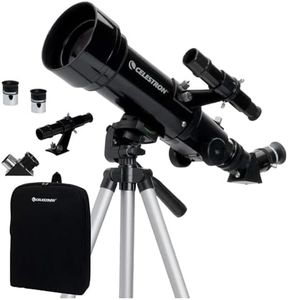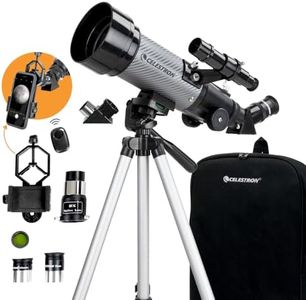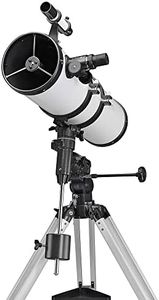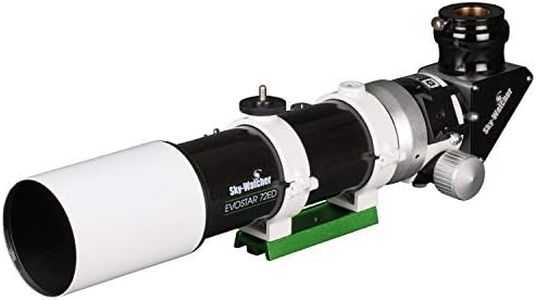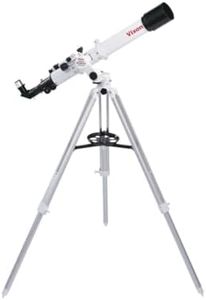We Use CookiesWe use cookies to enhance the security, performance,
functionality and for analytical and promotional activities. By continuing to browse this site you
are agreeing to our privacy policy
10 Best Telescopes For Viewing Planets
From leading brands and best sellers available on the web.Buying Guide for the Best Telescopes For Viewing Planets
Choosing a telescope for viewing planets is an exciting journey that opens up the wonders of the night sky. When picking a telescope, it’s important to focus on features that will help you see details clearly, such as the rings of Saturn or the bands on Jupiter. Understanding which factors contribute to bright, sharp planetary views will help you navigate the various options and find the best fit for your needs, whether you’re observing from your backyard or planning for more ambitious stargazing sessions.Aperture SizeThe aperture is the diameter of the telescope's main light-gathering lens or mirror, and it's a crucial factor because it determines how much light the telescope can collect. A larger aperture allows you to see fainter objects and finer details on planets. Typically, telescopes with apertures of around 70mm-100mm are suitable for casual planetary viewing, while those in the 100mm-150mm range offer a better balance between portability and detail. If you want even sharper and brighter images, especially for more serious observation, look for apertures in the 150mm-200mm or above. Your choice should depend on how much detail you want to see and how much space you have for storing and using the telescope.
Focal Length and Focal RatioThe focal length is the distance between the telescope's main lens or mirror and the point where it forms an image. The focal ratio is the focal length divided by the aperture, often labeled as 'f/' followed by a number. For planetary viewing, a longer focal length (and a higher focal ratio, such as f/8 or above) generally provides higher magnification and a narrower field of view, which is desirable for seeing planets up close. Consider telescopes with longer focal ratios if your primary interest is detailed views of planets, though shorter focal ratios can be more versatile if you also want to try wider-field observing.
Mount TypeThe mount is the support structure that holds the telescope steady and allows you to aim it. There are two main types: altazimuth (moves up/down and left/right) and equatorial (follows the rotation of the sky). For planetary viewing, stability is key, because high magnification can make even tiny vibrations disruptive. Altazimuth mounts are simpler and suitable for beginners, while equatorial mounts require a bit more setup but make it easier to track planets as they move across the sky. Consider how comfortable you are with setting up and using each type, and how important smooth tracking is to your enjoyment.
Eyepieces and MagnificationEyepieces determine the magnification you get from your telescope, and most telescopes come with one or two to get you started. For planet viewing, higher magnification eyepieces let you see features like Saturn’s rings or Jupiter’s Great Red Spot, but too much magnification can make the image fuzzy if the conditions or telescope quality don’t support it. It's generally best to have a range of eyepieces, choosing lower magnifications for finding planets and higher ones for close-up views. Make sure your telescope can accommodate different eyepieces, and remember that image quality and steadiness matter more than simply reaching very high magnification values.
Optical DesignTelescopes come in different optical designs, such as refractors, reflectors, and compound or catadioptric types. Refractors are often praised for their crisp planetary images and low maintenance, while reflectors generally offer larger apertures for the money but may require occasional alignment. Compound designs combine advantages of both and are compact. Your choice here will depend on your priorities: simplicity and sharp images (refractor), more light-gathering for your budget and interest in tweaking the scope (reflector), or portability and versatility (compound).
Portability and Ease of UseIf you plan to move your telescope frequently or have limited storage space, size and weight can be key factors. Smaller and lighter telescopes are easier to set up and transport, making the hobby more enjoyable if you prefer convenience or want to observe from different locations. However, smaller telescopes may show less planetary detail. Consider how and where you plan to use the telescope most often—at home, in a car, or on foot—and balance portability with your desire to see as much detail as possible.



